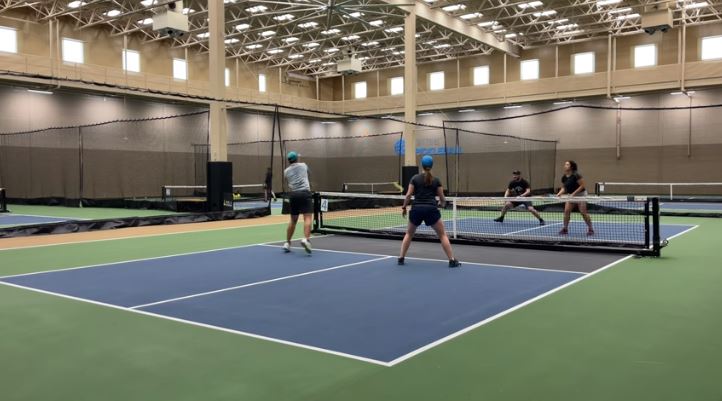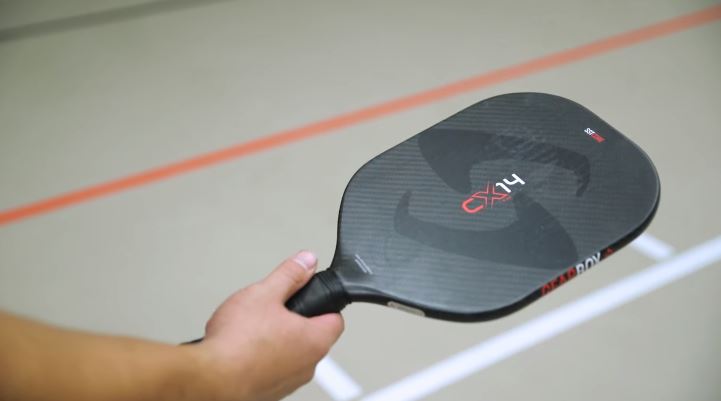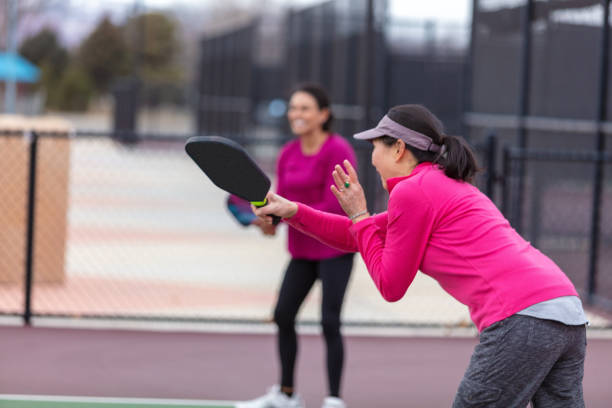This article will tell you how to hold a pickleball paddle correctly. It will include different types of gripping techniques, factors to consider when selecting a grip type, how to hold the paddle, common mistakes to avoid, and practice drills for improving your grip technique.
How to hold a pickleball paddle?
Explanation of pickleball and the importance of proper handling of paddle
Pickleball is a very famous sport that combines the elements of tennis, badminton, and ping-pong. It is excitingly played with a paddle and a plastic ball on a court that is smaller than a tennis court. A proper paddle grip is necessary for pickleball because it affects your control over the ball, power, and accuracy. Without a good grip, it can be difficult to hit the ball effectively, and you may experience discomfort or pain in your hand.
This article will tell you how you may hold a pickleball paddle correctly. It will include different types of gripping techniques, factors to consider when selecting a grip type, how to hold the paddle, common mistakes to avoid, and practice drills for improving your grip technique.
Types of Paddle Grips

Eastern Grip
The Eastern grip comprises placing the base knuckle of your index finger on the edge of the paddle and wrapping your fingers thoroughly around the handle. The Eastern grip is popular among tennis players and provides good control and accuracy for volleys and groundstrokes. However, it may not be as effective for hitting overhead shots or generating power.
- Gives better control and accuracy for volleys and groundstrokes
- Comfortable grip for players with relatively smaller hands
- May not be that much effective for hitting overhead shots or generating power
- Can be hard to hit hard shots
Continental Grip
The Continental grip involves placing the base knuckle of your index finger on the corner of the paddle and wrapping your fingers around the handle. The Continental grip is a versatile grip that allows you to hit a variety of shots with power and accuracy. It is commonly used for serving, overhead shots, and volleys.
- Provides extreme power and accuracy for tremendous shots
- Comfortable and easy grip for players with larger hands
- May not offer as much control for groundstrokes
- Can be a bit harder to hit slice shots
Western Grip
The Western grip comprises placing the base knuckle of your index finger on the middle of the paddle and wrapping your fingers around the handle. The Western grip is popular among tennis players and provides good power for groundstrokes and overhead shots. However, it may not be as effective for volleys or hitting accurate shots.
- Provides a nice power for groundstrokes and overhead shots
- Good grip for players with strong wrists
- May not provide as much control for volleys or hitting accurate shots
- Can be a bit uncomfortable for players with smaller hands
Comparison of the three grip types
Each grip type has its advantages and disadvantages, and the best grip for you will depend on your individual needs and playing style. It is important to try different grip types and see which one feels most comfortable and effective for your game.
How to Choose the Right Grip
Factors to consider when selecting a grip type

Choosing the right grip for your pickleball paddle can greatly impact your playing style and overall performance. Therefore, it’s important to consider several factors when selecting a grip type.
Hand size and strength
One of the main considerations when choosing a grip type is your hand size and strength. If you have larger hands or are stronger, you may find it more comfortable and effective to use a grip that allows you to generate more power, such as a Western grip. If you have smaller hands or are weaker, you may prefer a grip that allows for more control, such as an Eastern or Continental grip.
Playing style
Your playing style can also influence which grip type you choose. If you prefer to play aggressively and generate a lot of power, a Western grip may be more suitable for you. If you prefer a more defensive style and prioritize control and precision, an Eastern or Continental grip may be more appropriate.
Comfort
It’s important to choose a grip type that feels comfortable to you. A comfortable grip can help you maintain a consistent grip on the paddle throughout the game, and minimize the risk of injuries.
Tips for testing different grip types
Once you have considered the above factors, it’s a good idea to test out different grip types to determine which one feels most comfortable and effective for your playing style. Here are some tips for testing different grip types:
Use demo paddles
Many sporting goods stores offer demo paddles that you can try out before making a purchase. This can be a great way to test out different grip types without committing to one.
Ask for advice
Talk to more experienced pickleball players or coaches about their preferred grip type and ask for their advice on which one may work best for you.
Try different grip types during practice
During your regular practice sessions, try using different grip types to get a feel for each one. You can then compare your performance and comfort levels to help determine which grip type to use during games.
By considering the above factors and testing out different grip types, you can find the grip that works best for you and improve your overall performance on the pickleball court.
How to Hold the Paddle

Proper hand placement on the paddle handle
The first step in holding a pickleball paddle is to make sure that your hand is in the correct position on the handle. The handle should be placed in the crease of your hand between your thumb and index finger. This will allow you to comfortably grip the handle and have better control over your shots. Make sure that you are not holding the paddle too close to the top, as this can result in less control and power.
How to grip the paddle with the fingers and thumb
Once you have positioned your hand correctly on the handle, you should grip the paddle with your fingers and thumb. The grip should be firm but not too tight, allowing you to maintain control over the paddle without straining your hand or wrist. You should grip the paddle with your fingers and thumb, making sure that your other fingers are relaxed and not gripping the paddle too tightly.
Tips for maintaining a comfortable grip during play
It is important to maintain a comfortable grip on the paddle throughout the game to prevent fatigue and injury. Some tips for maintaining a comfortable grip include shaking out your hands between points, adjusting your grip as needed for different shots, and using a grip-enhancing product such as grip tape or gloves. Additionally, it is important to make sure that the weight and size of the paddle are appropriate for your individual needs and playing style, as this can affect your grip and overall performance.
Practice Drills for Grip Technique
Importance of practicing proper grip technique
Practicing proper grip technique is crucial for improving your pickleball game. A consistent grip can help you generate more power, control, and accuracy with your shots. It also helps you avoid injury and fatigue by minimizing stress on your wrist and arm muscles.
Drills for improving grip strength and flexibility
One of the most important aspects of the pickleball grip technique is grip strength and flexibility. Strong and flexible hands can help you grip the paddle firmly without exerting too much pressure, which can cause fatigue and strain.
There are several drills you can do to improve your grip strength and flexibility. One example is the squeeze and release exercise, which involves holding a ball or other small object in your hand and squeezing it for a few seconds before releasing it. Repeat this exercise several times with each hand.
Another helpful exercise is finger stretches, where you stretch your fingers by pulling them back gently towards your wrist and holding the stretch for a few seconds before releasing.
Drills for reinforcing proper grip placement during play
In addition to improving grip strength and flexibility, it’s important to reinforce proper grip placement during actual gameplay. One way to do this is by practicing drills that focus on specific shots, such as forehand and backhand drives, volleys, and dinks.
For example, you can practice forehand drives by hitting the ball to a specific target while focusing on maintaining a consistent grip throughout the shot. Another drill for reinforcing proper grip placement is the shadow drill, where you practice your swings without a ball to focus on your technique and grip.
Practicing these drills regularly can help you develop muscle memory for proper grip technique and improve your overall game.
Frequently Ask Questions
Conclusion
Summary of key points
In this section, you should briefly summarize the key points that have been discussed in the article. You can do this by highlighting the most important ideas from each section and rephrasing them clearly and concisely. This will help the reader to remember what they have learned and reinforce the main takeaways.
Importance of finding the right grip for your individual needs
Here, you should emphasize the importance of selecting the right grip for your individual needs. You can discuss how this will help you to play better, more efficiently, and with less strain or injury. You can also mention how different grip types are suited to different playing styles, and how experimentation and practice are essential for finding the best fit.
Final thoughts on the importance of proper paddle grip in pickleball
Finally, you can conclude the article by summarizing the overall importance of proper paddle grip in pickleball. You can discuss how to grip technique is a fundamental aspect of the game, and how mastering this skill can help you to achieve your goals and enjoy the sport more fully. You can also encourage readers to continue to learn and grow as players by seeking out new resources, practicing regularly, and playing with others who can challenge and inspire them.
Gripping the paddle too tightly
Holding the paddle too tightly can result in unnecessary tension in your arm and wrist, which can negatively affect your performance. It’s important to grip the paddle firmly but not too tightly to maintain control without causing discomfort or strain.
Holding the paddle too high or too low
Holding the paddle too high or too low can make it difficult to hit the ball with proper technique and may result in poor shot placement. It’s important to hold the paddle at a comfortable height that allows for proper swing and control.
Failing to adjust grip during different types of shots
Different shots in pickleball require different grips, and failing to adjust your grip can result in poor shot placement and loss of control. It’s important to practice different grips and be able to switch between them seamlessly during play.
Tips for correcting these mistakes
To correct these mistakes, start by paying attention to your grip and how it feels during play. Practice adjusting your grip between shots and find a grip that feels comfortable and allows for proper technique. Additionally, make sure to take breaks and stretch your arm, hand, and wrist muscles to reduce tension and prevent injury.
